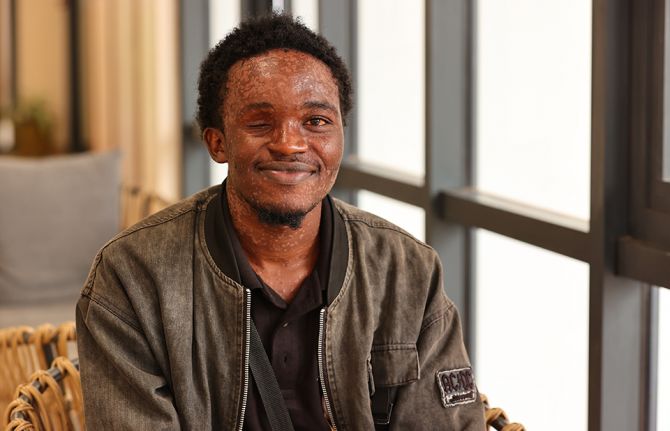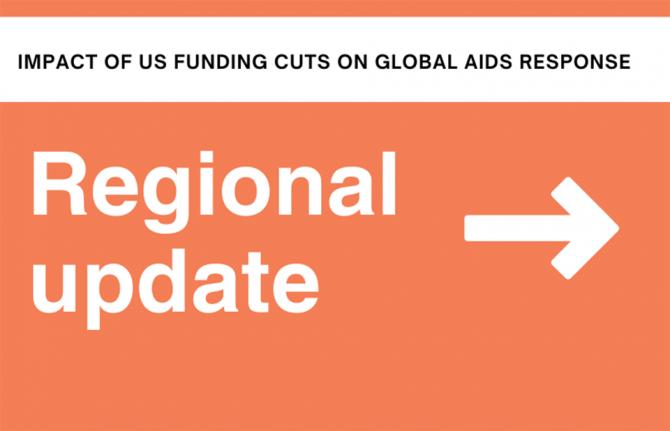
Feature Story
Art for AIDS: A sculptor’s voice
06 December 2007
06 December 2007 06 December 2007
"Fighting HIV is not a one man show – it involves
not just UNAIDS but a lot of organizations and
countries. It involves everyone".
Artist Mike Munyaradzi was born in 1967 in Guruve, Zimbabwe. The son of world famous sculptor Henry Munyaradzi, Mike started his apprenticeship at the early age of 13 under the guidance of his father. In the second part of a special three part series on Art for AIDS. Mike shares his experiences as an artist and discusses the meaning of his Eradication sculpture and how artists have a role to play in the AIDS response.
How and why did you first become involved in the Art world?
I grew up with it. I probably started doing work when I was only 13 years old – from that age I was able to make small things – watching and trying to copy my father. I didn’t go to an art school - I learned from him.
What are your inspirations and influences in your art?
Mainly nature - from animals. And from the culture of my tribe, the Shona and Ndebele people. I also get a lot of inspiration from the modern world we are living in and then from the natural shapes of the stone itself. Whenever I look at a raw stone, I try to say to myself, ok, what can I bring out of that shape naturally?
You learned from your father – what was the best lesson he gave you?
The best thing I think is he told me to respect the natural shape of the stone. He used to say to me “whenever you are working with a stone, try not to destroy the natural shape of the stone, try to harmonize, work in accordance with the natural shape.” I To me, every raw stone is a sculpture in waiting – it just needs to be brought out.
‘Eradication’ – can you tell us how this whole project started?
The idea of commissioning a piece came out of collaboration with Dimitris from Ruwa Gallery and UNAIDS. It needed to be a big stone, and it was very difficult to find the right one. Drawings were sent to and fro and eventually I started working on the sculpture and one day they said ok stop - that’s great! The sphere represents the globe. I hollowed it out as if I were cleaning – and that represents the efforts being made. Fighting HIV is not a one man show – it involves not just UNAIDS but a lot of organizations and countries. It involves everyone.
We need to cleanse the earth, not just of HIV but also of malaria, TB, global warming. The sculpture represents throwing out everything dead from our mother earth and reconstructing it. I put in three spheres – one on one side and two on the back. They symbolize joint efforts - not one person, not one organization but a lot of people. The one at the top is complete, it’s emerging out of the rock - it’s a new world coming out of the rock.
The leaf at the top – what does this signify?
The leaf signifies the .life in this world as we know, trees are life and that is the symbol of the life we are all trying to keep afloat with all the problems we are having – so that is the symbol of the leaf.

Sometimes it might be difficult to explain to them
about HIV – about preventative methods, about
what young people should do. But with art we are
free to show that we should be able to protect
ourselves.
Some days I would wake up and look at the rock, before it was even a sculpture, and try to see what it was suggesting to me. The globe at the front was actually in the stone and what I needed to do was follow the shape and hollow it out. We’ve just been talking about the leaf – in fact that natural shape was in the raw stone – if you look at the raw stone it was like a leaf.
Sometimes I’d run out of ideas and all I could do was walk around the stone and look at it. Another morning I’d wake up full of ideas and get straight down to work. I’d also seek the opinions of other people, other artists.
What do you hope people are going to get out of the sculpture?
I hope they see the need to work together to eradicate the problems of our mother earth. I hope they understand why the globe is so smooth – I could have made it rough, spiky, but I wanted to say: “OK, we’ve got these problems but it doesn’t mean it’s the end of the world. We can still work on them and get over them.”
In my country, Zimbabwe, and in Africa, there is a lot of stigma, but there is work going on to dispel that stigma. I hope my sculpture will contribute to that and will encourage more organizations to become involved in HIV-related work
Art coming out of Zimbabwe is traditionally more figurative – your piece is more abstract, how feel about this?
It’s true that before, I wasn’t doing a lot of abstracts. But now, since ‘Eradication’, I’ve become motivated to try some more. “Eradication” was a good challenge.
As an artist, what is your role in the AIDS response?
We artists can play a major role. I can naturally sculpt something in relation to AIDS and show it to my people. Sometimes it might be difficult to explain to them about HIV – about preventative methods, about what young people should do. But with art we are free to show that we should be able to protect ourselves.
Will you continuing working on AIDS issues?
I will, especially after this project, yes.
Links:
Three-part series on Art for AIDS:
Part 1: Art for AIDS: A sculptor’s voice
Part 2: Art as an inspiration
Part 3: More than words: ART for AIDS
Listen to interview with sculptor Mike Munyaradzi
Read feature story - Contemporary African art and AIDS
Read feature story - Secretary General visits UNAIDS, Geneva



